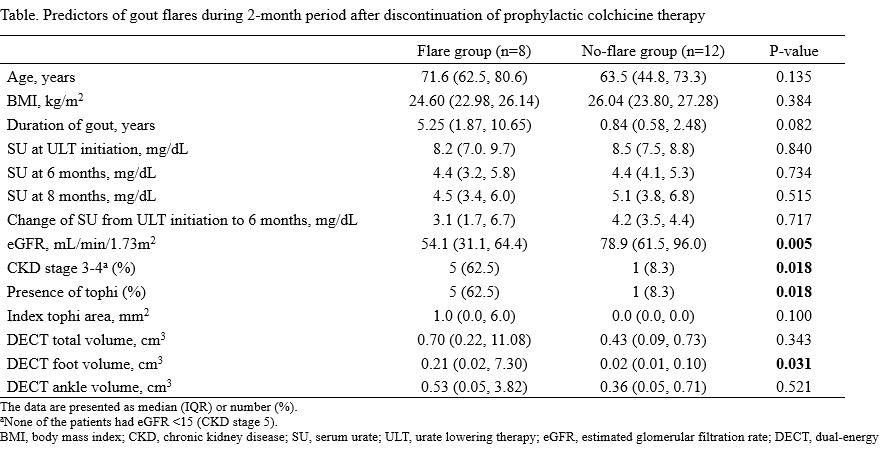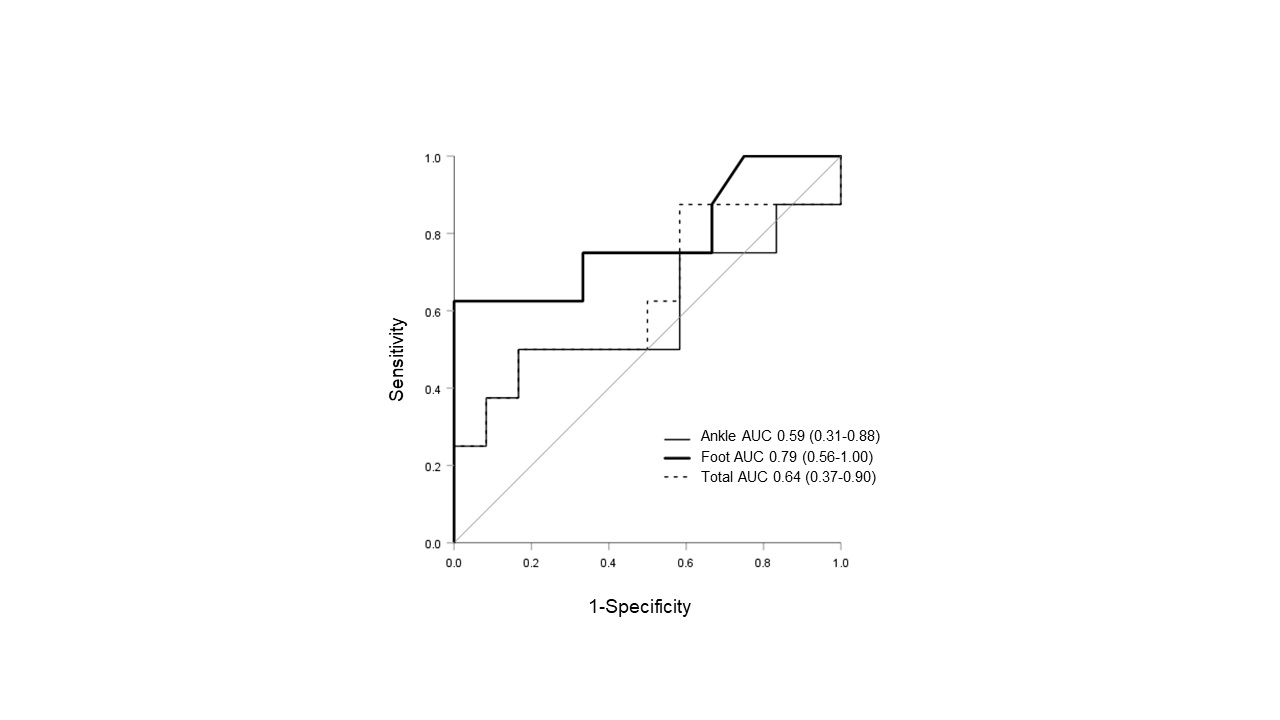Back
Poster Session D
Crystal arthropathies
Session: (1787–1829) Metabolic and Crystal Arthropathies – Basic and Clinical Science Poster
1802: The Utility of Dual-energy Computed Tomography in Gout Patients During Urate Lowering Therapy
Monday, November 14, 2022
1:00 PM – 3:00 PM Eastern Time
Location: Virtual Poster Hall
- MK
Min Jung Kim, MD
Seoul Metropolitan Government Boramae Medical center
Dongjak-gu, Seoul, South Korea
Abstract Poster Presenter(s)
Min Jung Kim1, Mi Hyeon Kim2, SE RIM CHOI2, Youjin Jung2, Ji In Jung2, Ju Yeon Kim2, Jee Won Chai3 and Kichul Shin4, 1Seoul Metropolitan Government Boramae Medical center, Dongjak-gu, Seoul, Republic of Korea, 2Seoul National University Hospital, Seoul, Republic of Korea, 3Seoul Metropolitan Government–Seoul National University Boramae Medical Center, Seoul, Republic of Korea, 4Seoul Metropolitan Government- Seoul National University Boramae Medical Center, Seoul, Republic of Korea
Background/Purpose: To investigate whether monosodium urate (MSU) deposition measured by dual-energy computed tomography (DECT) could help predict acute flares after discontinuing colchicine prophylaxis in patients with gout.
Methods: This prospective observational pilot study included patients with gout meeting the 2015 ACR/EULAR gout classification criteria who received urate lowering therapy (ULT) and a prophylactic dose of colchicine for 6 months. DECT was performed at the time point when colchicine was discontinued. Images of a preselected unilateral foot and ankle were analyzed for the measurement of MSU volume by a musculoskeletal radiologist. Patients were divided into those who had a flare and those who did not during a 2-month period following colchicine discontinuation. Differences in clinical and DECT findings between the two groups were analyzed. The predictive value of MSU volume for flares was assessed using the area under the receiver-operating-characteristic curve (AUC).
Results: Twenty-three patients were enrolled: the MSU volume of 20 patients were assessed. The index tophi area on physical exam well correlated with the total MSU volume (rho 0.575, p=0.010). Eight (40%) of the 20 patients experienced a flare over a 2-month period after discontinuing colchicine. The flare group had more tophi on physical exam (62.5% vs. 8.3%, p=0.018) and more patients with chronic kidney disease (CKD) (62.5% vs. 8.3%, p=0.018). The no-flare group had considerably lower foot MSU volume than the flare group (0.02 vs. 0.21 cm3, p=0.031). The foot MSU volume yielded an AUC of 0.79 for predicting a flare after discontinuing colchicine.
Conclusion: Our study shows that the presence of tophi and CKD may require a longer period of colchicine prophylaxis. Patients with little or no MSU deposits on the foot/ankle 6 months after initiating ULT had a lower risk of flare after discontinuing prophylaxis. Longitudinal measurements of MSU volume in patients with a high initial urate burden may help determine the optimal duration of prophylaxis.

 Figure. Receiver-Operating-Characteristic curves for the monosodium urate (MSU) volume measured by dual-energy computed tomography (DECT) to predict gout flare during 2 months after discontinuation of prophylactic colchicine therapy. AUC, area under the curve.
Figure. Receiver-Operating-Characteristic curves for the monosodium urate (MSU) volume measured by dual-energy computed tomography (DECT) to predict gout flare during 2 months after discontinuation of prophylactic colchicine therapy. AUC, area under the curve.
Disclosures: M. Kim, None; M. Kim, None; S. CHOI, None; Y. Jung, None; J. Jung, None; J. Kim, None; J. Chai, None; K. Shin, None.
Background/Purpose: To investigate whether monosodium urate (MSU) deposition measured by dual-energy computed tomography (DECT) could help predict acute flares after discontinuing colchicine prophylaxis in patients with gout.
Methods: This prospective observational pilot study included patients with gout meeting the 2015 ACR/EULAR gout classification criteria who received urate lowering therapy (ULT) and a prophylactic dose of colchicine for 6 months. DECT was performed at the time point when colchicine was discontinued. Images of a preselected unilateral foot and ankle were analyzed for the measurement of MSU volume by a musculoskeletal radiologist. Patients were divided into those who had a flare and those who did not during a 2-month period following colchicine discontinuation. Differences in clinical and DECT findings between the two groups were analyzed. The predictive value of MSU volume for flares was assessed using the area under the receiver-operating-characteristic curve (AUC).
Results: Twenty-three patients were enrolled: the MSU volume of 20 patients were assessed. The index tophi area on physical exam well correlated with the total MSU volume (rho 0.575, p=0.010). Eight (40%) of the 20 patients experienced a flare over a 2-month period after discontinuing colchicine. The flare group had more tophi on physical exam (62.5% vs. 8.3%, p=0.018) and more patients with chronic kidney disease (CKD) (62.5% vs. 8.3%, p=0.018). The no-flare group had considerably lower foot MSU volume than the flare group (0.02 vs. 0.21 cm3, p=0.031). The foot MSU volume yielded an AUC of 0.79 for predicting a flare after discontinuing colchicine.
Conclusion: Our study shows that the presence of tophi and CKD may require a longer period of colchicine prophylaxis. Patients with little or no MSU deposits on the foot/ankle 6 months after initiating ULT had a lower risk of flare after discontinuing prophylaxis. Longitudinal measurements of MSU volume in patients with a high initial urate burden may help determine the optimal duration of prophylaxis.

 Figure. Receiver-Operating-Characteristic curves for the monosodium urate (MSU) volume measured by dual-energy computed tomography (DECT) to predict gout flare during 2 months after discontinuation of prophylactic colchicine therapy. AUC, area under the curve.
Figure. Receiver-Operating-Characteristic curves for the monosodium urate (MSU) volume measured by dual-energy computed tomography (DECT) to predict gout flare during 2 months after discontinuation of prophylactic colchicine therapy. AUC, area under the curve. Disclosures: M. Kim, None; M. Kim, None; S. CHOI, None; Y. Jung, None; J. Jung, None; J. Kim, None; J. Chai, None; K. Shin, None.

